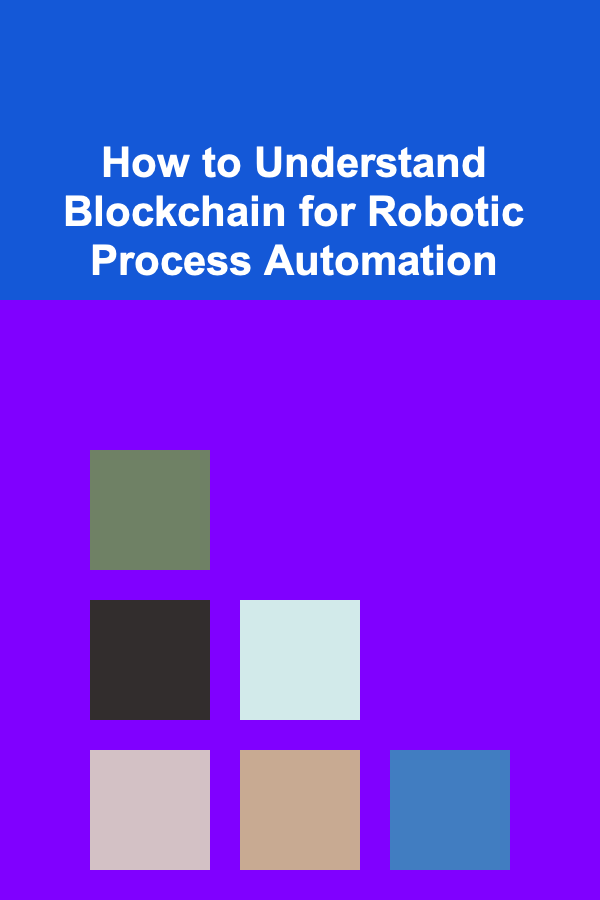
How to Understand Blockchain for Robotic Process Automation
ebook include PDF & Audio bundle (Micro Guide)
$12.99$6.99
Limited Time Offer! Order within the next:

Blockchain and Robotic Process Automation (RPA) are two of the most transformative technologies in the current digital landscape. While they serve different purposes, combining the strengths of both can offer significant improvements in efficiency, transparency, and security for businesses across various industries. In this article, we will delve into how Blockchain can be used in conjunction with RPA to enhance business processes, ensuring a deeper understanding of both technologies and their synergistic potential.
What is Robotic Process Automation?
Robotic Process Automation (RPA) refers to the use of software robots or "bots" to automate repetitive, rule-based tasks typically performed by humans. These tasks can include data entry, report generation, transaction processing, and customer service. RPA utilizes artificial intelligence (AI) and machine learning (ML) to mimic human actions, making it possible to complete tasks faster, more accurately, and without human intervention.
RPA is widely adopted across industries such as banking, healthcare, manufacturing, and logistics due to its ability to reduce operational costs, increase speed, and eliminate human error. However, one of the limitations of RPA is that it lacks the capability to ensure security, data integrity, and transparency in processes, which is where Blockchain comes into play.
What is Blockchain?
Blockchain is a decentralized, distributed ledger technology that allows data to be stored across a network of computers in such a way that it is nearly impossible to alter or tamper with. Each block in the blockchain contains a list of transactions, and once data is added to the blockchain, it is immutable, meaning it cannot be changed or deleted without consensus from the network.
Blockchain operates through a consensus mechanism that ensures trust and verification without the need for a central authority. It has become widely known for its application in cryptocurrencies, but its potential extends far beyond this to include areas such as supply chain management, healthcare, and more.
The key features of Blockchain include:
- Decentralization: No single entity controls the network; instead, control is distributed across many nodes (computers) in the network.
- Transparency: All participants in the network can view the blockchain's transactions, providing full transparency.
- Security: The use of cryptographic techniques makes it extremely difficult to alter any data once it has been added to the blockchain.
- Immutability: Once a transaction is recorded, it cannot be changed or deleted, ensuring data integrity.
The Synergy Between Blockchain and RPA
While RPA enhances operational efficiency by automating routine tasks, it lacks the mechanisms to ensure data security and authenticity. Blockchain, with its decentralized and tamper-proof nature, can offer a complementary layer of security and transparency to automated processes.
Let's explore the ways in which Blockchain can be integrated into RPA to provide an added advantage:
1. Enhanced Security
One of the primary concerns with RPA is security. Bots perform operations that deal with sensitive data, and if these bots are compromised, the entire process could be jeopardized. By leveraging Blockchain's cryptographic security, RPA processes can be safeguarded against tampering, fraud, or unauthorized access.
In a Blockchain-enabled RPA system, every transaction processed by the bots can be recorded on the Blockchain, ensuring that each step in the automation process is auditable and secure. This can help businesses achieve compliance with industry regulations, such as GDPR or HIPAA, which require data to be stored securely and access to it to be restricted.
2. Improved Transparency and Auditability
Blockchain's transparency can enhance the auditability of RPA processes. As every transaction is recorded on the blockchain and time-stamped, businesses can trace each step in an automated process to ensure that tasks were completed correctly and without tampering.
This level of transparency is especially useful in industries such as finance, healthcare, and logistics, where compliance and auditing are critical. If there is ever a need to audit or review an automated process, Blockchain provides an immutable record that can be easily accessed and verified, reducing the complexity and cost of audits.
3. Increased Trust and Accountability
Blockchain creates a system of trust without the need for intermediaries. This feature is particularly useful in RPA scenarios that require multiple parties to interact, such as supply chain management, banking, or any other domain that involves third-party vendors.
For instance, in supply chain management, RPA bots can automate the procurement process. With Blockchain, the details of every transaction, including purchases and shipments, are securely logged and verified. This provides all parties involved with a transparent view of the entire process, reducing the likelihood of disputes and fostering trust between partners.
4. Decentralization of Automated Processes
RPA is typically centralized, with bots interacting with a central system to perform tasks. However, combining Blockchain with RPA allows for the decentralization of these processes. With Blockchain, each node in the network can verify and authenticate transactions, ensuring that RPA bots can operate independently while still maintaining trust and transparency.
Decentralization is particularly important in situations where multiple parties need to work together without a central authority. For example, in cross-border payments, different financial institutions can use Blockchain to validate and verify transactions, while RPA bots automate the payment processing and reconciliation steps.
5. Smart Contracts for Automation
Smart contracts are self-executing contracts with the terms of the agreement directly written into code. These contracts run on blockchain platforms like Ethereum and automatically execute actions when predefined conditions are met.
By integrating RPA with smart contracts, businesses can automate complex workflows that involve multiple steps and parties. For example, in a real estate transaction, a smart contract can automatically transfer ownership of a property once payment has been received. RPA bots can handle the data entry, document management, and notification processes, while the smart contract ensures that the agreement is executed once the conditions are met.
6. Data Integrity and Verification
In many RPA implementations, bots interact with external systems and databases to retrieve or input data. Ensuring that this data is accurate and tamper-proof is critical, especially in industries like healthcare, finance, and insurance, where data integrity is paramount.
Blockchain ensures that the data being processed by RPA bots is not tampered with and can be verified. For example, a healthcare provider could use Blockchain to store patient records. RPA bots could then automate the retrieval and processing of these records, with Blockchain ensuring that the data has not been altered or corrupted during the process.
7. Cost Reduction in Fraud Prevention
Fraud is a major concern in automated systems, especially when financial transactions are involved. Blockchain provides a solution by ensuring that every transaction is verified and recorded in a way that cannot be altered or falsified.
By using Blockchain in conjunction with RPA, businesses can automate fraud detection and prevention. RPA bots can automatically flag suspicious activities, while Blockchain ensures the integrity and authenticity of the transaction data, reducing the chances of fraud.
Real-World Applications of Blockchain and RPA Integration
1. Supply Chain Management
Supply chains are complex networks that involve many parties, from suppliers to distributors to customers. Blockchain can improve visibility and trust in the supply chain, while RPA can automate the execution of various tasks, such as inventory management, order processing, and invoicing.
For instance, RPA bots could automate the task of tracking shipments, generating invoices, and updating inventory levels. Blockchain can record every transaction in the supply chain, ensuring transparency and providing a clear, immutable audit trail.
2. Banking and Financial Services
In banking and finance, RPA is already being used to automate tasks such as loan processing, customer onboarding, and regulatory compliance. Blockchain can be used to add an additional layer of security and transparency to these processes.
For example, RPA bots could automate the processing of cross-border payments, while Blockchain ensures that each payment is securely verified and recorded. Additionally, smart contracts can be used to automate the execution of agreements, such as loan disbursements or insurance claims.
3. Healthcare
In healthcare, RPA is being used to automate administrative tasks such as scheduling appointments, processing insurance claims, and updating patient records. Blockchain can ensure the security and integrity of patient data, while RPA handles the workflow automation.
By integrating Blockchain with RPA, healthcare providers can automate the process of verifying patient data and ensuring that the data remains accurate and secure. Blockchain ensures that no tampering or unauthorized access occurs, while RPA streamlines the administrative processes.
4. Insurance
RPA in insurance can be used to automate claims processing, policy management, and customer service. Blockchain can enhance this process by ensuring that every claim is securely recorded and that the data remains transparent and immutable.
For example, a smart contract could automatically trigger the approval of a claim once the required conditions are met, while RPA bots can handle tasks such as data entry, customer notifications, and document management.
Conclusion
Blockchain and Robotic Process Automation are powerful technologies on their own, but when combined, they can deliver unprecedented levels of security, transparency, and efficiency. By using Blockchain to enhance RPA, businesses can ensure the integrity of their automated processes, reduce fraud, improve compliance, and increase trust between parties.
Understanding how Blockchain can improve RPA requires a clear grasp of both technologies and how they complement each other. As these technologies continue to evolve, businesses that adopt them will be better positioned to succeed in the increasingly complex and competitive digital landscape.
Reading More From Our Other Websites
- [Mindful Eating Tip 101] How Mindful Eating Certification Transforms Client Results (and Your Business)
- [Stamp Making Tip 101] Cost-Effective Branding: Why Custom Stamps Are a Smart Investment for Small Enterprises
- [Organization Tip 101] How to Create Custom Patterns with Carpet Tiles in Your Home
- [Stamp Making Tip 101] Troubleshooting Common Stamp-Making Mistakes and How to Fix Them in Your Scrapbooks
- [Survival Kit 101] Best Survival Kit for Cyclists Who Ride Long Distances on Rural Roads
- [Home Family Activity 101] How to Create a DIY Family Art Gallery at Home
- [Reading Habit Tip 101] Why Nonfiction Can Be Your Secret Weapon for Innovation
- [Home Storage Solution 101] How to Utilize Under-the-Bed Space for Maximum Storage
- [Organization Tip 101] How to Use QR Codes for Easy Access to Travel Information
- [Home Party Planning 101] How to Ditch the Paper: A Comprehensive Guide to Paperless Party Invitations and RSVPs

How to Create a Stylish Home Bar Without Overspending
Read More
How to Share Your Seasonal Organization Tips Online
Read More
How to Use Digital Tools for Effective Document Management
Read More
Why One-Page Websites Are Perfect for Creative Professionals and Artists
Read More
How To Teach Your Children a Second Language
Read More
How to Create a Blogging To-Do List That Actually Works
Read MoreOther Products

How to Create a Stylish Home Bar Without Overspending
Read More
How to Share Your Seasonal Organization Tips Online
Read More
How to Use Digital Tools for Effective Document Management
Read More
Why One-Page Websites Are Perfect for Creative Professionals and Artists
Read More
How To Teach Your Children a Second Language
Read More